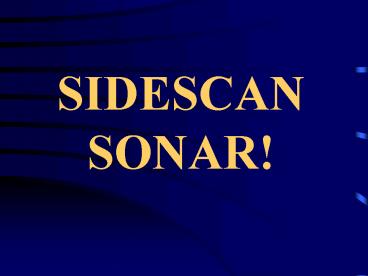SIDESCAN SONAR! PowerPoint PPT Presentation
1 / 27
Title: SIDESCAN SONAR!
1
SIDESCAN SONAR!
2
Some terminology
Footprint Seafloor area sampled by a single
acoustic signal pulse. Fish An instrument
towed behind a ship -- e.g. sidescan sonar and
its casing. Hull The main body or structure of
a ship.
3
Sidescan sonar
Multibeam bathymetry
4
Hull-mounted vs towed
- Hull-mounted (i.e., most swath bathymetry
systems) - Are continually mounted on the ship dont
require repeated deployment - Can collect data while ship is being used for
other purposes (e.g., physical oceanographic
cruise) - Fast surveying (ship can travel at 10 knots)
- Acoustically noisy (near-surface turbulence and
ship noise) - Resolution constrained by near-sea-surface
location (i.e., cant go lower to get more
detailed picture of seafloor) - Hard to access for repairs
- Can only be used with certain hull shapes
5
Hull-mounted vs towed
- Towed (i.e., most sidescan sonar systems)
- Easier to move from ship to ship
- Operate in quieter water at greater depth
- Must be deployed each cruise
- At deployment, ship speed must be near zero
- Location of fish with respect to ship must be
measured or calculated
6
Basic physics Sidescan sonar
- A set of transducers on the instrument transmits
acoustic energy through the water column - Energy encounters seafloor
- Energy can be
- Reflected
- Refracted (Snells Law) through substrate
- Scattered/reradiated from seafloor features
7
Basic physics Sidescan sonar
- Sidescan instrument collects the backscattered
energy returning from the seafloor. - Produce images of the topography or roughness of
the sea floor based on the strength of the energy
backscattered off of the seafloor. - Images kind of look like aerial photographs, but
are produced using sonar rather than light.
Illuminated features. - Reflectivity is often used in place of
backscatter (although strictly speaking,
reflected energy is different from backscattered
energy).
8
Instrument design/data collection
- Two outgoing sonar signals, one to either side
of the instument. Beams expand with distance
from the instrument. - Directly beneath instrument nadir no
signal. - Slightly different frequencies on each side (11
kHz for port and 12 kHz for starboard) to
decrease interference between return signals on
each side. - Strength of returned signal is assigned value 0
to 255 (0 black and 255 white). Translated
into pixels.
9
Image interpretation
- Strong returned energy (hard bottom, no
sediments) dark on a light background. Like
shining a black flashlight on the seafloor.
(GLORIA and TOBI are opposite.) - Picture of roughness of the seafloor.
Sedimented abyssal plains low roughness.
Faults, fissures, slopes, new volcanic features
high roughness/high reflectivity. - Lots of geometric (angle) corrections. Requires
computer processing. Fish depth, bathymetry,
look angle, speed of survey, frequency,
repetition of pings, acoustic noise, track
curvature. - Data duplication/deletion at turns.
10
Image interpretation
- Features perpendicular to shiptrack are
deemphasized (underensonified), while features
parallel to shiptrack are overemphasized
(overensonified). - Simulated sun at a low grazing angle.
Shadows (sonic, not light).
11
GLORIA
12
GLORIA
GLORIA Geological Long-Range Inclined
ASDIC ASDIC Anti-Submarine Detection and
Investigation Committee Southampton Oceanography
Centre and USGS Towed 200 m behind the ship. Tow
depth 30-60 m Depth range up to 11 km Emits a
pulse every 30 seconds. Survey speed 12 knots
13
DSL-120
(DSL Deep Submergence Laboratory (WHOI))
14
DSL-120
15
SeaMarc II
No current photo available
16
HMR1
17
Coaxial Segment, Juan de Fuca R.
18
(No Transcript)
19
Coaxial segment,Juan de Fuca Ridge
20
Coaxialsegment,Juan de FucaRidge
21
Coaxialsegment,Juan de FucaRidge
22
Puna Ridge
Kilauea first began erupting in 1983. Lateral
protrusions of magma (dikes) rift
zones Southwest Rift Zone. East Rift Zone 55
km from summit to shore, then another 75 km
underwater. Puu Oo site of current Kilauea
eruption (20 km from summit) Puna Ridge
submarine portion of East Rift Zone R/V Thompson
(U.W.) and DSL-120. Explore submarine magma
transport processes.
23
Finding shipwrecks
s/s Paula Faulbaum Oct. 18, 1941, headed just
south of Stockholm, Sweden Raining, wind blowing
at 18-20 m/s Hit aground, took on water. Crew
abandoned ship. Next morning, ship had sunk. Bow
is 40 m deep, stern is 70 m deep.
24
Finding shipwrecks
25
Finding shipwrecks
26
Finding shipwrecks
s/s Nedjan. Built in Scotland in 1893. 64 m
long. January 1954 Departed Sweden. Overnight,
steering malfunctioned and she started to drift.
Lost off the coast. No survivors (crew of 17).
Found in 1996 at 32 m depth using sidescan.
27
(No Transcript)

